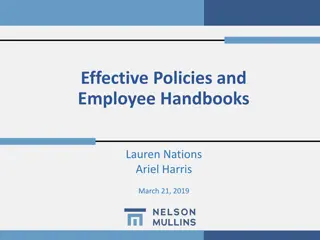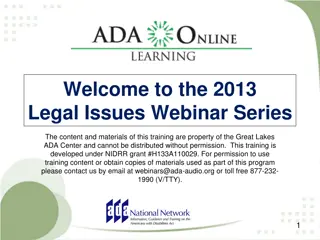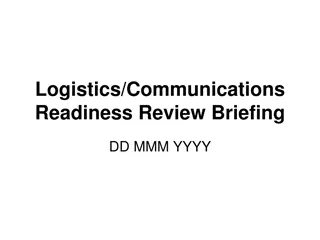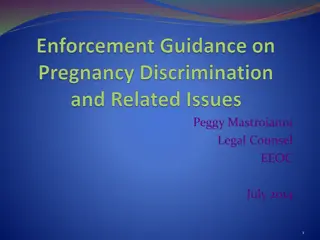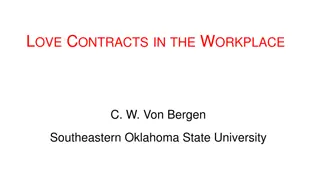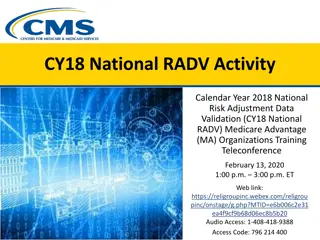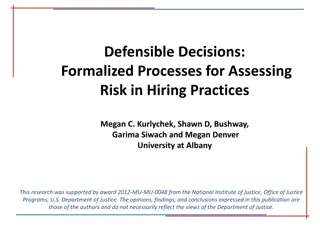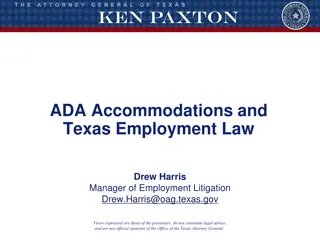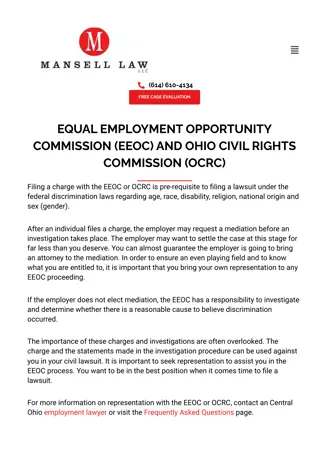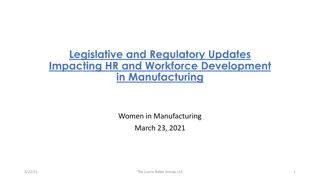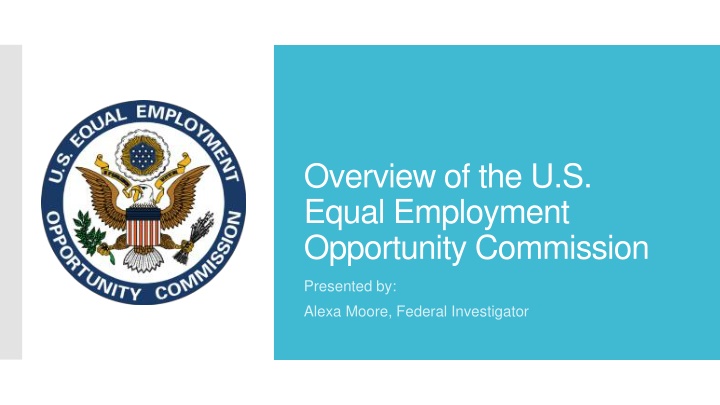
U.S. Equal Employment Opportunity Laws and Jurisdiction
Explore the laws enforced by the U.S. Equal Employment Opportunity Commission (EEOC) and its jurisdiction, learn about priority topics, best practices for employers, and who is covered by these employment discrimination laws.
Download Presentation

Please find below an Image/Link to download the presentation.
The content on the website is provided AS IS for your information and personal use only. It may not be sold, licensed, or shared on other websites without obtaining consent from the author. If you encounter any issues during the download, it is possible that the publisher has removed the file from their server.
You are allowed to download the files provided on this website for personal or commercial use, subject to the condition that they are used lawfully. All files are the property of their respective owners.
The content on the website is provided AS IS for your information and personal use only. It may not be sold, licensed, or shared on other websites without obtaining consent from the author.
E N D
Presentation Transcript
Overview of the U.S. Equal Employment Opportunity Commission Presented by: Alexa Moore, Federal Investigator
Learn about laws enforced by the EEOC and the agency s jurisdiction Training Objectives Learn about the EEOC s priority topics to better identify such issues in your communities Brief overview of general best practices for employers
U.S. Equal Employment Opportunity Commission Bipartisan Commission Created over 50 years ago as part of the Civil Rights Act of 1964 Law enforcement agency Investigations, mediations and litigation Workshare agreement with state and tribal civil rights agencies
Title VII Of the Civil Rights Act of 1964 Americans with Disabilities Act of 1990, amended 2008 Age Discrimination in Employment Act of 1967 Equal Pay Act of 1963 Genetic Information Non-Discrimination in Employment Act of 2008
Title VII of the Civil Rights Act of 1964 Race, color, national origin, religion, sex (pregnancy, sexual orientation, gender identity) Americans with Disabilities Act of 1990, amended 2008 Disability (actual, perceived as, and history of) EEOC Jurisdiction Age Discrimination in Employment Act of 1967 Age 40 years or older Equal Pay Act of 1963 Wage discrimination because of sex Genetic Information Non-Discrimination Act of 2008 Acquisition of or discrimination due to genetic information
U.S. EEOC MI MDCR Race Color All of the previous groups, plus Ancestry Religion Federal v. State Law Marital Status Sex (including pregnancy, gender identity, and sexual orientation) Medical Condition Military or Veteran Status National Origin Age (>40 years) Disability Genetic Information
Who is covered? Business/private employers State or local governments Federal government agencies Employment agencies Labor unions or join apprenticeship committees Employees Job applicants Former employees Applicants or participates in a training or apprenticeship program Employers must have 15+ employees to be covered by EEOC jurisdiction. *except the EPA
Statute of Limitations Most EEOC Offices: 300 days from the date of harm State Agencies: 180 days from the date of harm
Adverse employment action due to an applicant or employee s protected status or for engaging in a protected activity: Discipline Termination Wage disparity Denied a reasonable accommodation Harassment Constructive discharge What is discrimination? Protected activity: Filing an internal complaint Filing a charge with the EEOC or MDCR Participating in an investigation as a witness
Disparate Treatment Employee or applicant treated adversely because of their protected class Discriminatory motivation need not be conscious Adverse Impact Focus is on whether a policy has discriminatory effects that cannot be legally justified Disparate Treatment vs. Facially neutral policy or practice has a substantially greater negative impact on members of a protected class Adverse Impact
Protected Basis + Tangible Employment Action OR Elements of Harassment Hostile Work Environment + Liability = Illegal Harassment
APPROXIMATELY 70% OF EMPLOYEES NEVER COMPLAIN INTERNALLY 85% OF PEOPLE NEVER FILE A CHARGE Harassment is Significantly Underreported 70% 85%
Disability: physical or mental impairment which substantially limits one or more major life activities Covers: Individuals with a disability Record of disability Reasonable Accommodation Under the ADA Request can be verbal or in writing Interactive process Employer may request additional medical documentation if accommodation request needs clarification Discussion May be more than one effective accommodation option Leave may be considered as a reasonable accommodation Reasonable accommodation must be absent an undue hardship for the employer
Employers cannot take an adverse action against an individual for engaging in a protected activity filing a charge of discrimination participating in a discrimination proceeding otherwise opposing discrimination Complaint must indicate they believe treatment is due to a protected status Adverse action could create a chilling effect Must be a connection between the protected activity and the adverse action Retaliation
Percentage of Charges Filed by Types of Discrimination for FY 19 60 50 40 30 20 10 0 Michigan United States Race Sex National Origin Religion Color Retaliation (All) Age Disability EPA GINA
Eliminating Eliminating barriers in recruitment and hiring Enforcing Enforcing equal pay laws Strategic Enforcement Plan 2017-2021 Protecting Protecting immigrant, migrant and other vulnerable workers Addressing Addressing emerging and developing issues Preserving Preserving access to the legal system
Best Practices Implement a strong EEO policy embraced at the top levels of the organization. Train managers, supervisors and employees; enforce policy; and hold them accountable. Provide clear assurance that employees who make complaints or provide related information will be protected against retaliation Promote inclusive culture in the workplace by fostering an environment of professionalism and respect for personal differences. Foster open communication and early dispute resolution. Document, document, document!
www.eeoc.gov Detroit Field Office: (313) 226-4600 Contact the EEOC! Lolita Davis, Outreach & Education Coordinator: (313) 226-3783 Alexa Moore, Federal Investigator: (313) 226-4626 or alexa.moore@eeoc.gov


